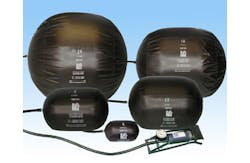How ASME 33.1 impacts welded pipe work in select process industries
By Dr. M. J. Fletcher
Recent years have witnessed exponentially increasing demand for improvements in piping-fabrication quality. The introduction of a new ASME piping code is a formal recognition of this emerging requirement that has been stimulated by industries such as pharmaceuticals, semiconductors and food production.
An essential element in pipe work is the production of welded joints and the stringent inspection procedures imposed by ASME 33.1, which apply as much to welded joints as they do to all the other fabrication processes involved. Besides the more general significance of the new code as it applies to the manufacture of high quality pipe work, producers of welding accessories have been quick to meet the challenges imposed by ASME 33.1 with new designs.
One fundamental requirements imposed during pipe welding is prevention of weld oxidation during the first pass. The welding torch provides inert gas coverage of the top of the fusion zone, but unless precautions are taken there is no coverage of the weld root. The problem has always been recognized and over the years a variety of solutions have evolved, some eccentric, others practical but largely ineffective.
Industry standards
Whilst minimum standards are set for all fusion-welding, their application to the pharmaceutical-, semiconductor- and food-production sectors demands particularly high standards of cleanliness. Hygienic purity is the driving force for joints destined for use in pharmaceutical and food production. Elimination of particulate contamination is the crucial requirement in semiconductor manufacture.
With some semiconductor manufacturers producing chips with dimensions at the 32-nanometer (nm) level, and research going on at the 15-nm level, it is easy to see why the design, fabrication, and maintenance practices required to ensure exacting purity requirements of their process fluid distribution systems are of paramount importance.
In the food processing industries, statutory legislation and a plethora of litigation suits have forced plant manufacturers to introduce quality-control levels previously considered unnecessary. Contamination introduced during fabrication is now unacceptable.
Recent work now indicates that for sensitive applications such as semiconductor manufacture, pharmaceutical production and food processing, oxygen levels in weld purge gas should be as low as 10 ppm (0.001%) if discoloration and loss of corrosion resistance is to be avoided. These requirements have placed a challenging burden on suppliers of weld purge equipment.
A solution suggested
Satisfying the high level of protection required follows from the selection of specialist "purging" equipment. Inserting screwed-up paper or other barrier material either side of the joint and filling the space between them with inert gas may be good enough for low-level quality but is totally unsuitable when faced with the requirements imposed by ASME 33.1.
Significant progress in purging equipment began from the 1980s when welding accessory manufacturers developed expanding plugs and inflatable stoppers (see figures 3 to 5).
These basic expandable and inflatable seal devices gave assurance of effective sealing with the pipe wall and prevented inert-gas leakage from the weld zone, precluding back-flow of oxidizing gases from the atmosphere. Generally effective, these developments still allowed considerable scope for innovative improvements. The ‘QuickPurge’ system (see Fig 6) from specialist supplier Huntingdon Fusion Techniques integrates a pair of inflatable bladders and provides pressure-controlled gas ports for both inflating and inert gas supplies.
Other systems have been designed to satisfy the requirements of pre and post weld heating through the use of thermally resistant materials (see Fig 7). Some are produced with no metallic materials in the weld vicinity so that post weld non-destructive testing can be undertaken with the purge system still in place.
There have been recent significant developments in gas-monitoring instruments to measure residual oxygen levels in the purge gas. For example, the ‘PurgeEye’ monitor (Fig 8) is designed specifically for measurement of low oxygen levels in purge gases during welding.
The challenges of the new ASME Piping Code have provided a stimulus for further developments and advanced versions of the commercial purge systems now becoming available. Some of these employ high-stability engineering polymers to cover all exposed metal components. Thus, the risk of transfer of metallic materials onto pipe surfaces is minimized. Many are able to provide fully automatic control over inert gas flow and pressure.
The welding supply industry is leading the way in responding proactively to the new demands imposed by ASME 33.1.
Michael Fletcher is a senior research and development consultant at Huntingdon Fusion Techniques and a metallurgy consultant with Delta Consultants.
Huntingdon Fusion Technologies, Bury Port, Dyfed, United Kingdom is a developer and manufacturer of weld-purging technology.
###
[Figure Captions]
1. Schematic section through tube joint showing gas seals on each side of the weld.
2. Effect of residual oxygen level in purge gas on finished weld. Top to bottom illustrations show oxygen content reducing from 3500 ppm (0.35%) to 300 ppm (0.03%) to 10 ppm (0.001%).
3. Aluminum body/rubber seal expanding plug in common use for tube sealing. Available for pipe sizes between 38 and 900 mm
4. Range of nylon body/rubber seal expandable stoppers. Compatible with pipe diameters from 12 to 150mm
5. Examples of Inflatable neoprene pipe seals for use on pipes up to 2400 mm
6. Inflatable system designed specifically for rapid deployment and incorporating gas entry and exit routes. These fully integrated purge systems represent the global industry standard for advanced purging equipment. They are available for pipe sizes between 25 and 2400 mm diameter
7. Thermally tolerant, fully integrated purge systems developed for use where pre- and post- weld heating is required. These can be used for prolonged exposure to temperatures up to 300C.
8. Sensitive monitoring instrument to measure oxygen content in purge gas. Recent developments in these examples are sensitive down to 10 ppm (0.001%) oxygen.
